For a number of years now, Tottenham Hotspur have struggled to become a consistent top-four team in the Premier League despite having several top-class attacking players at their disposal. Players such as Harry Kane and Heung-min Son have destroyed opposition defences on a consistent basis, yet Spurs are still unable to reach the heights of the likes of Liverpool and Manchester City. While they did achieve UEFA Champions League football by finishing fourth in 2021/22, they conceded 40 goals – the most of any top-four side, which is why it is a smart move to have invested in an established central defender.
The new defender is none other than Clément Lenglet of Barcelona, who has signed on loan for the 2022/23 season. Experienced in La Liga and the Champions League, the French International could be a key component for Spurs to reach the next level.
This data analysis will provide a statistical assessment of Lenglet – an analysis of how his 2021/22 statistics fair against Spurs’ centre backs’ using data from the 2021/22 campaign. Three key areas will be under analysis: defensive ability, on-the-ball ability, and a further scope on passing contributions. The players alongside Lenglet to be included are Cristian Romero, Davinson Sanchez, Eric Dier, Japhet Tangana, and Ben Davies (while Davies is naturally a left-back/left wing-back, he has featured for Spurs at CB last season), and will include statistics from each player in only the Premier League – domestic and European cups are not involved.
Player Profile
Lenglet has played 303 matches in professional football, with 301 of those coming at centre-back – the other two at left-back. Having impressed at French side AS Nancy-Lorraine, Lenglet earned a move to La Liga side Sevilla, where he continued to impress. He attracted the attention of many big clubs around Europe, but Barcelona were the ones to secure his signature – he has since gone on to make more than 150 appearances for the Spanish giants. He is also a French international, with 15 senior caps to his name, achieving a UEFA Nations League title during that time.
As you can see from his heat map below, he has been more likely to feature on the left side of a back four than anywhere else, but his role may slightly differ in this respect in Spurs’ three-at-the-back system, depending on where Antonio Conte wishes to play his new signing.
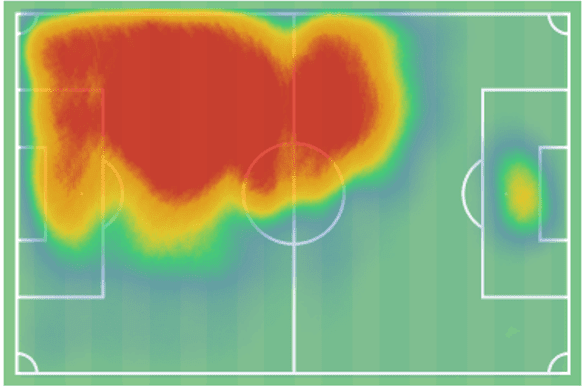
Defensive attributes
While a modern defender must be able to contribute to their team’s possession and attacks, defensive values are still of extreme importance. Below, we take a look at some major components when it comes to defending such as duels, tackling, and interceptions.
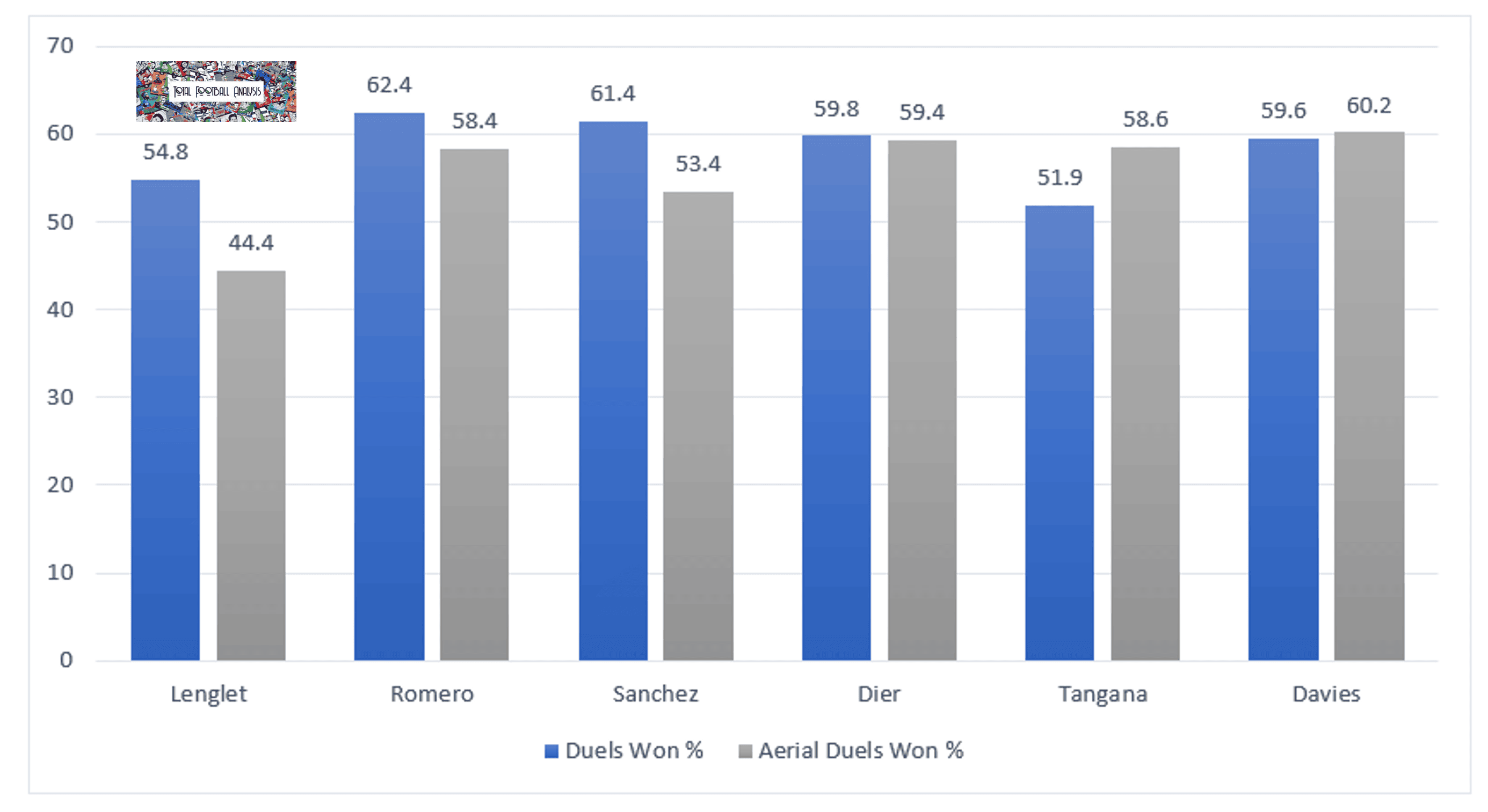
This first graph shows us two metrics for each defender – the percentage of overall duels won, and the percentage of aerial duels won. This gives us a strong foundation of just how defensively sound each player is. While there is no immediate standout, we can see that Romero is a strong defensive presence with success rates of 62.4% and 58.4% for duels won and aerial duels won respectively. Sanchez also impresses in overall duels, with a win rate of 61.4% – the second-highest behind Romero. According to the data, Ben Davies is Spurs’ most efficient central defender in the air, winning 60.2% of his aerial battles – this may be related to him playing some games at LB/LWB rather than being part of the back three, but his aerial ability should be credited, nonetheless.
Lenglet’s data in this light does not look the healthiest – he has the lowest aerial success rate of the selected players (44.4%) and his overall duels success rate of 54.8% is not great either. Of course, as with all the data interpreted in this report, it is circumstantial and does not mean he has nothing to contribute to Conte’s side defensively. However, these are numbers that he will want to improve on in the upcoming campaign.
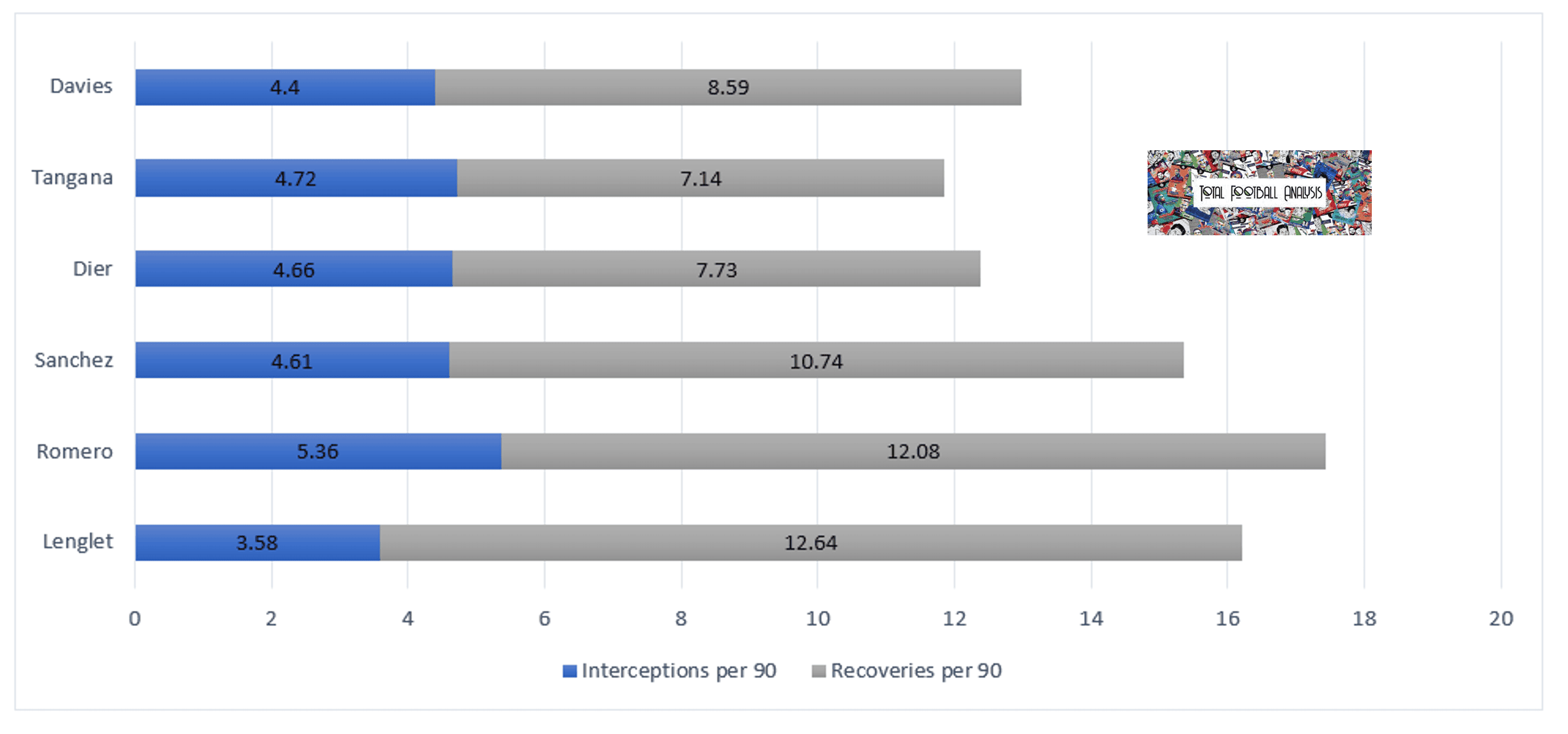
The stacked bar graph above lets us see what each player is like at reading the game and winning the ball. It allows us to get a good idea of who has strengths in both intercepting the ball to break up opposition play as well as who makes a good number of recoveries. Again, Romero stands out as the statistical favourite, making 5.36 interceptions per 90 and 12.08 recoveries per 90, suggesting a good understanding of the game and how to use that to his advantage. Davinson Sanchez also impresses again with his entries of 4.61 interceptions and 10.74 recoveries per 90 – his power and speed give him a huge helping hand with closing down the ball in certain phases.
Lenglet impresses in this area despite having the lowest rank for interceptions, averaging 3.58 per 90. His strength lies in recovering the ball from the opposition, showing a good ability to read situations, good timing to know when to step in to challenge, and good defensive strength to come away with the ball. His average of 12.64 recoveries per 90 is higher than that of any Spurs CB from last season’s Premier League. Spurs haven’t been strangers to counter-attacking goals in recent times, and with Lenglet adding to their ability to snatch the ball away from the opponent, this could open up more counter-attacking opportunities.
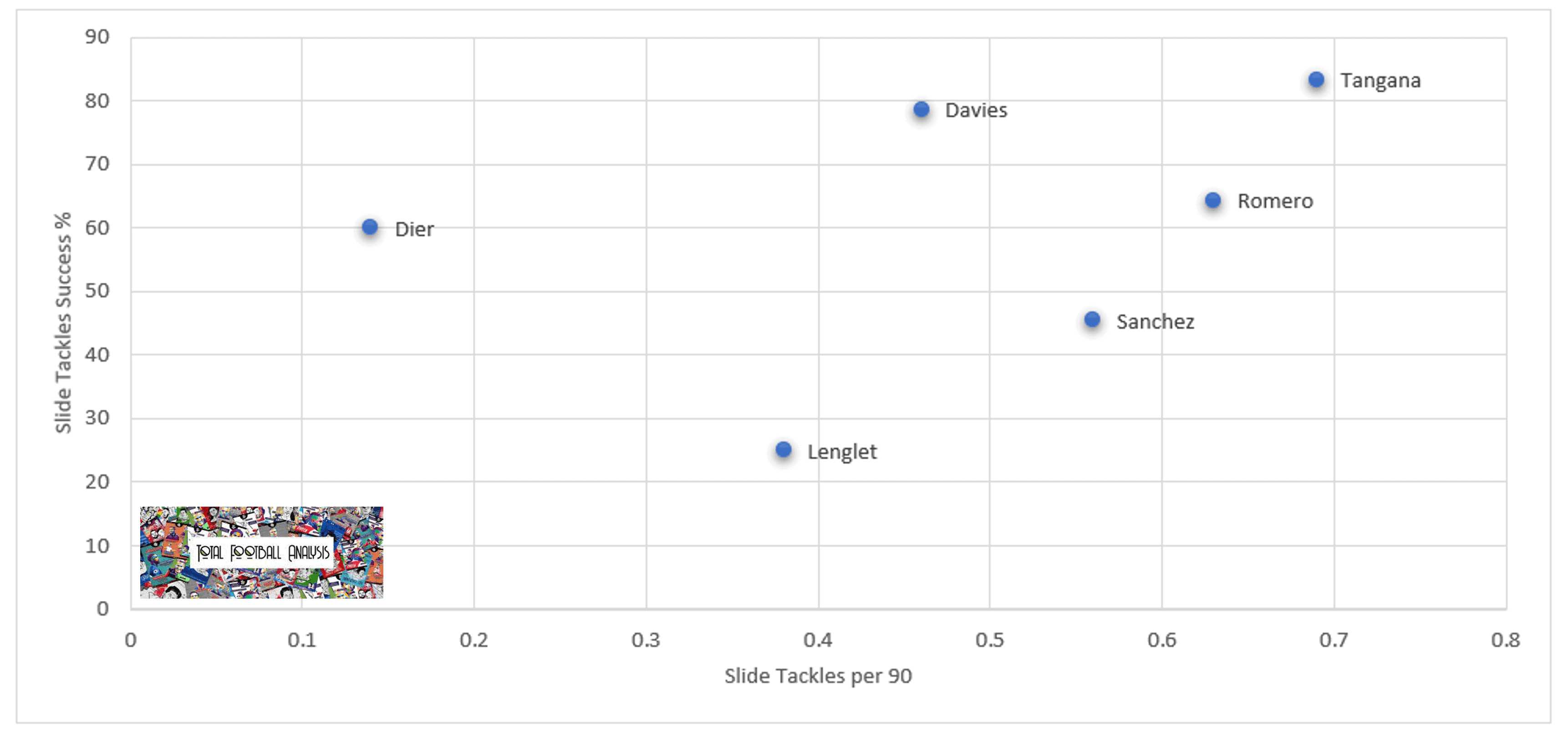
Moving on to our final defensive data analysis, we now look at each player’s ability to perform a sliding tackle having already discussed their efforts in overall duels. In the eyes of many, slide tackles are becoming a lost art, due to the evolution of defending but also due to rules and officiating being less lenient with these kinds of challenges. Nevertheless, they are still an important component of a defender’s arsenal as they show an array of traits such as bravery, timing, confidence, strength, and defensive technical ability. The scatter graph above tells us how often each defender attempts a slide tackle, and how efficient they are in the art. Immediately, Tangana is the name that jumps out, boasting the highest numbers in both attempts per 90 (0.69) and success rate (83.3%).
Lenglet clearly isn’t all that used to slide tackles, which again could be argued as circumstantial – the Spanish league is often less physical and with Barcelona typically dominating possession, slide tackles aren’t necessary. Still, based on last season, Lenglet isn’t Spurs’ best choice for slide tackling, with an average of 0.38 attempts per 90 and a success rate of just 25%. Winning just a quarter of your slide tackles as a central defender could be a cause for concern and it may be something that Conte tells Lenglet to avoid.
On the ball
As previously mentioned, the possession of strong abilities on the ball is vital for central defenders in the modern game, especially for clubs competing in elite European competitions such as the Champions League. Below is an analysis of the data drawn from each player when it comes to passing and dribbling, and we will also discuss how many times each player gives the ball away.
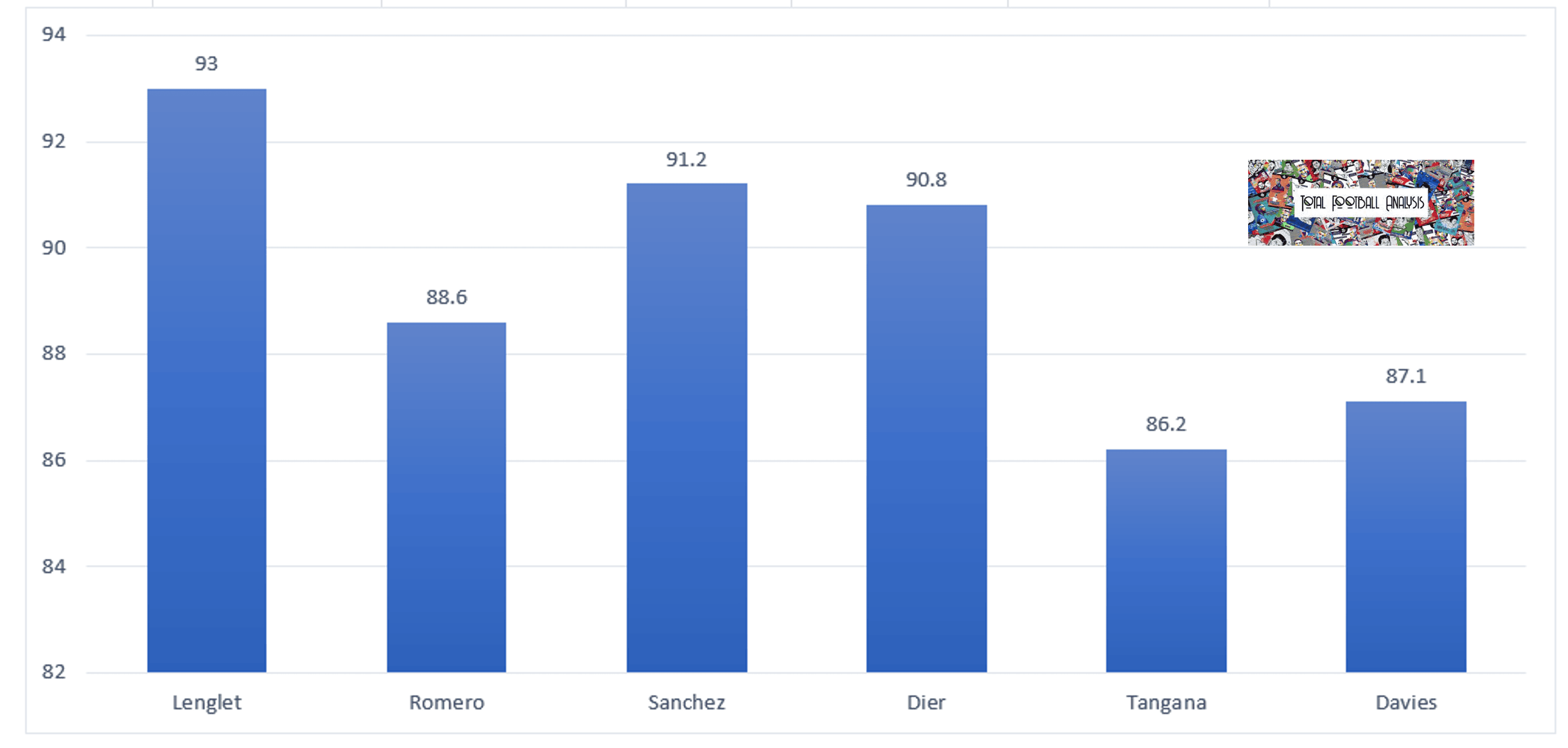
Pass accuracy is a basic yet essential data metric to judge a player on – a player isn’t likely to catch the eye of a scout in a positive way if he gives the ball away too many times. With Lenglet being at Barcelona for multiple years, it would be easy to assume that he possesses the ability to play with the ball at his feet. Well, at least when it comes to overall passing, the Frenchman is more than capable, with a pass accuracy of 93%, higher than any other Tottenham CB last season. Sanchez (91.2%) and Dier (90.8%) are both also impressive in this area.
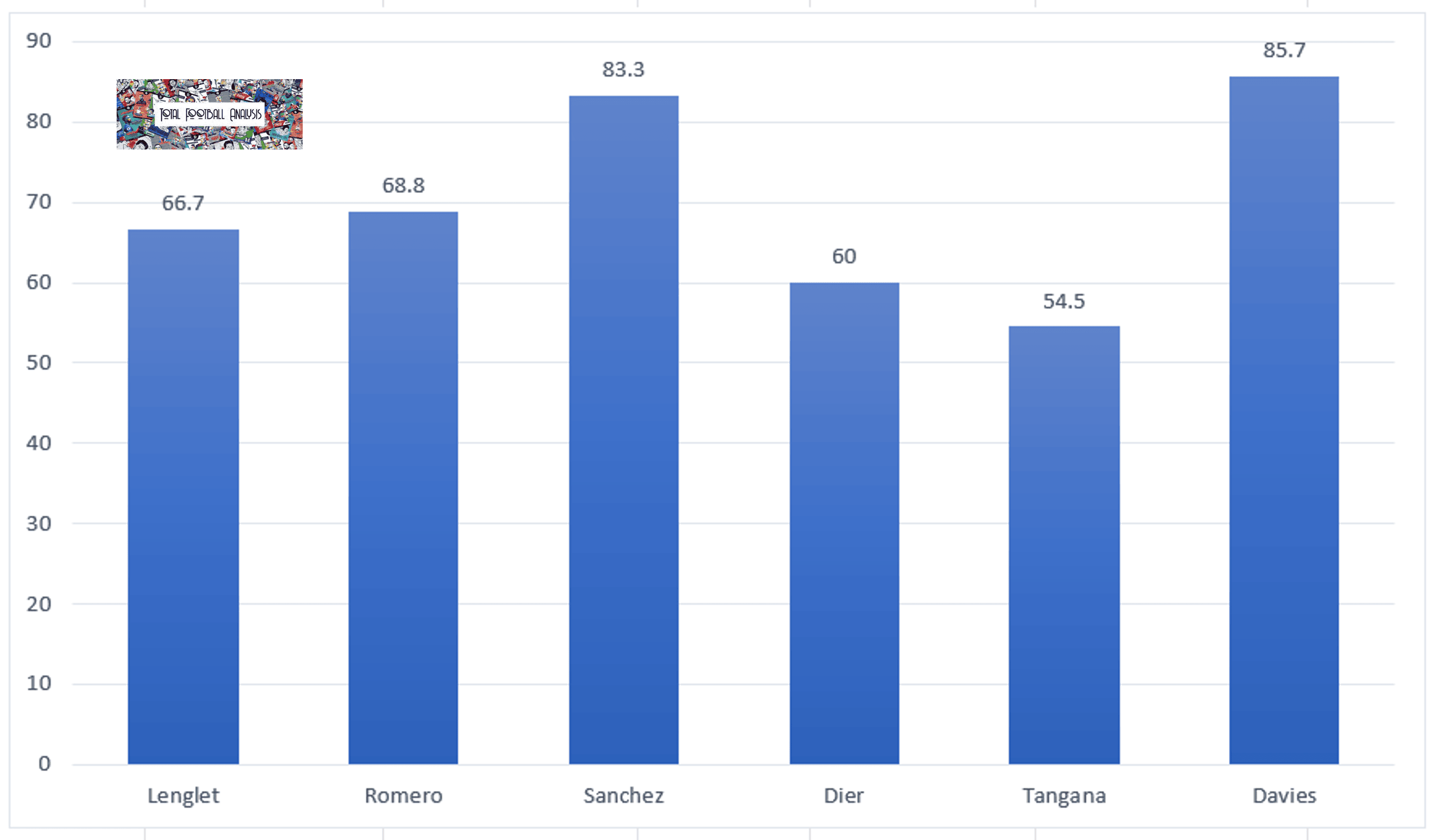
While dribbling may not be considered a key attribute of a central defender, it is still an important skill to possess as it allows them to either escape danger where passing is not an option, or it allows them to drive forward into the midfield third. It won’t come as a surprise that Ben Davies’ dribbling success rate, seen in the bar graph above, is the highest of Spurs’ CBs with a success rate of 85.7% – again his role as a left-back/left-wing back comes into play with this. Sanchez (83,3%) is highlighted in yet another positive light, and Lenglet is around the average mark with a success rate of 66.7%. This suggests that he is capable of the occasional dribble but it is not his most valuable asset on the ball, that appears to be his passing ability.
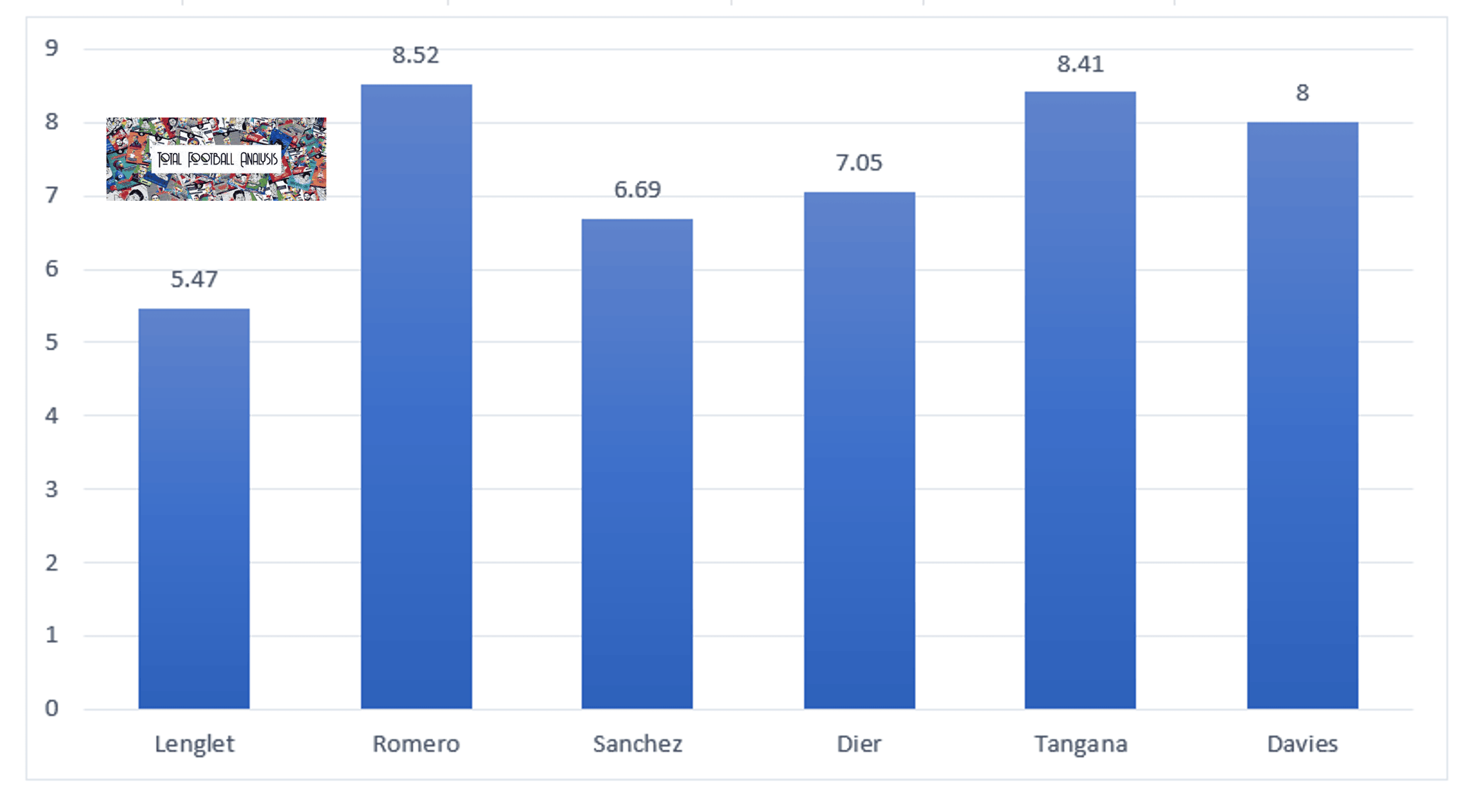
We now move on to the analysis of how often each player loses the ball. The graph above gives us an average per 90 of that exact metric, with new signing Lenglet recording the lowest and best score, losing the ball 5.47 times per 90 minutes. This suggests composure on the ball as well as an ability of general comfort on the ball. Players such as Romero (8.52) and Tangana (8.41) don’t come off too nicely in this piece of data and it’s certain to be an area for improvement.
Diving deeper into passing attributes
The initial analysis of data paints the picture that Lenglet has a special talent to be a ball-playing defender thanks to his impressive passing stats. This may have been the selling point from Barcelona and may have been the difference-maker for Spurs to pull the trigger and make the signing. With that in mind, we will now look further into his passing data to see exactly where he can be of optimal use for his side.
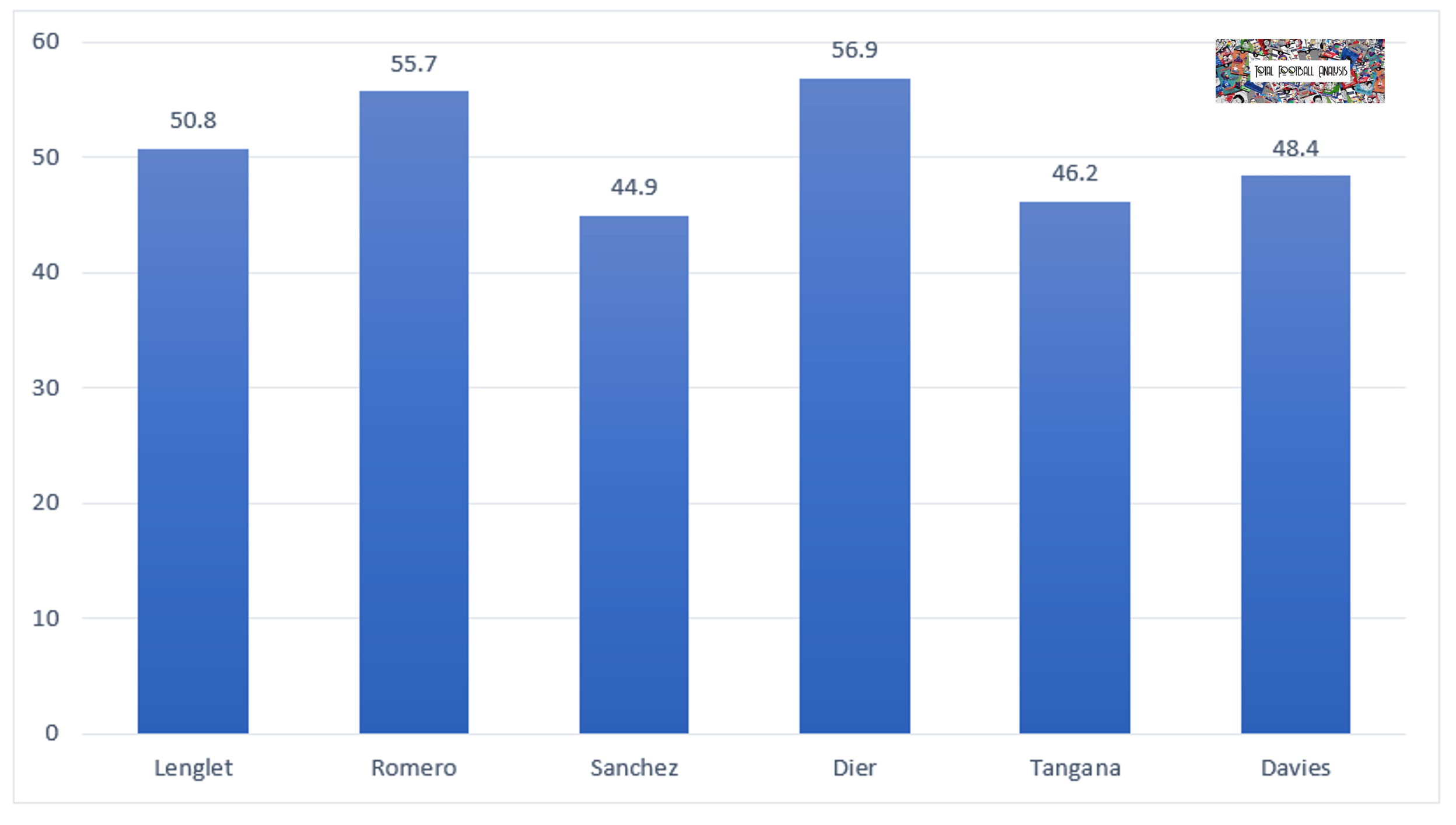
This first graph compares the long passing accuracy of each player. Even teams who don’t play route one football occasionally require the odd long ball from their defender in various scenarios, so it is a very useful skill to have in the locker. Lenglet records an accuracy rate of 50.8%, which is the third-highest in the group. Eric Dier is the man with the best long passing accuracy last season, with a success rate of 56.9% – his midfield roots proving useful.
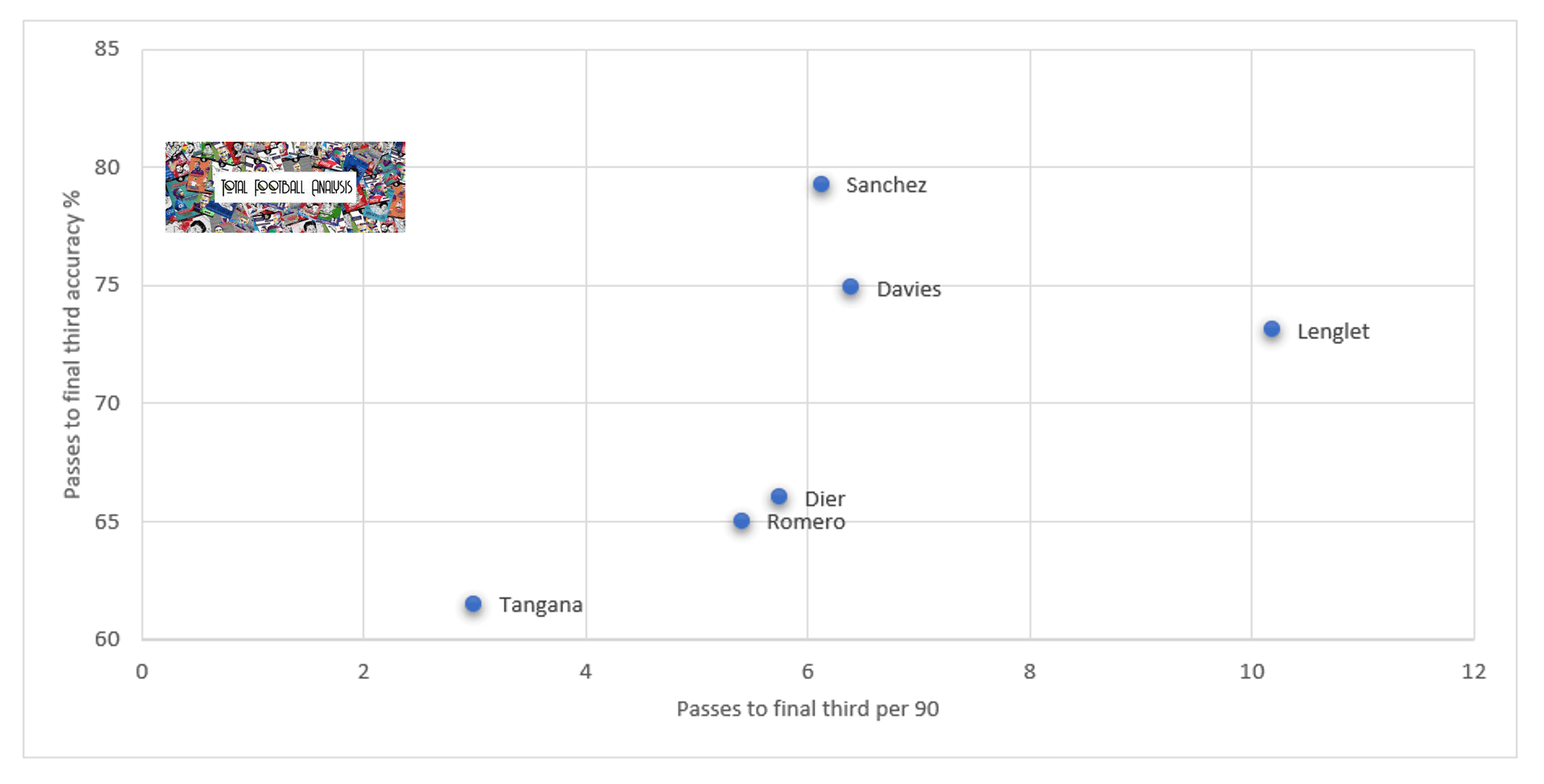
As a defender, being able to break lines and play passes into more attacking regions is a vital and somewhat difficult skill, but one that can escalate basic possession into a dangerous attack in the blink of an eye. In line with that, the scatter graph above provides an analysis of the number of passes into the final third each player makes per 90 and how accurate they are.
At first glance, Lenglet stands out thanks to his high ranking of 10.19 attempts per 90. This shows that he is consistently looking to make that unit-splitting pass that can take his team into the attacking third. His accuracy of 73.1% is the third-highest of the group and suggests that this is another special skill in his locker that Spurs could tap into. Sanchez is the man most accurate when it comes to passing into the final third with an accuracy rating of 79.3%.
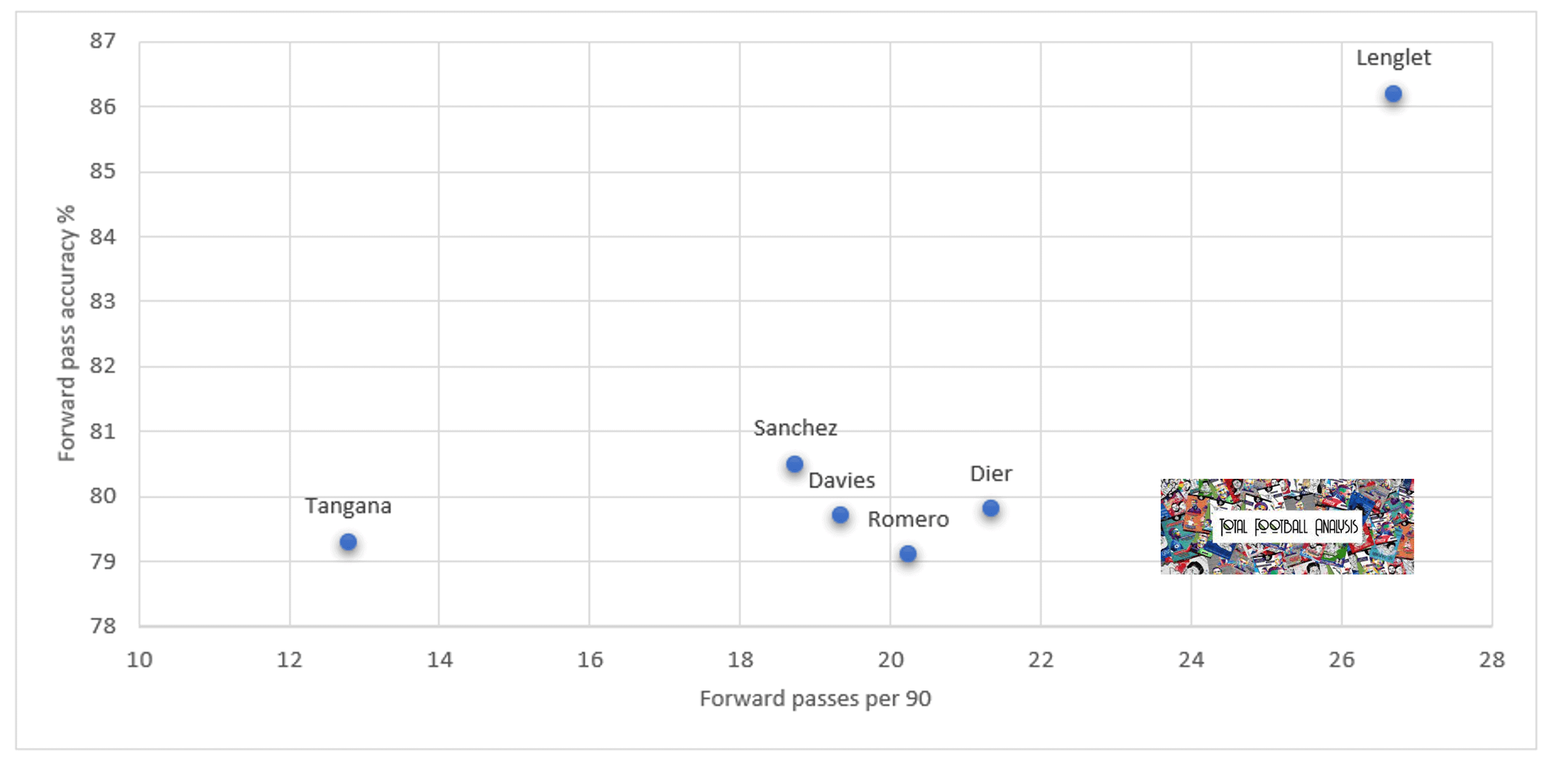
The final assessment is an analysis of each player’s tendency to make forward passes and their accuracy in doing so. Some teams in recent years have resorted to making sideways or even backwards passes to maintain a grip on possession, but this is a move hated by fans when used too frequently. The ability to pass forward shows an intent to progress the attack rather than holding the ball for the sake of it.
On the graph above, it may initially look as though we have forgotten to include Lenglet in this analysis segment, but his number of forward passes per 90 (26.7) and his accuracy with them (86.2%) is far higher than anyone else in the group, placing him in the top right of the graph. Essentially, he is extremely capable of passing forward – frequently and accurately.
Conclusion
Lenglet had a rough year at Barcelona last season, finding it hard to maintain status as a regular starter, but this data analysis suggests he may be something of a coup for Tottenham Hotspur. While his data in defending is nothing ground-breaking and adds some depth to the ranks, his statistical record on the ball may actually take Conte’s defensive unit to the next level itself. Lenglet excels in a range of passing and rarely gives the ball, making him a reliable man to carry the ball into the midfield third while significantly reducing the risk of a sloppy giveaway. This, of course, all rests on whether or not he can hit the ground running at Spurs and keep himself fit. If he can tick those two boxes, he could be a very important player for Conte in 2022/23.






Comments